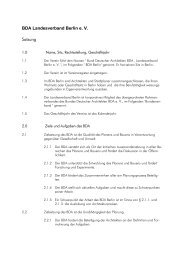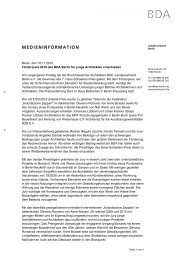Download PDF - BDA Berlin
Download PDF - BDA Berlin
Download PDF - BDA Berlin
Sie wollen auch ein ePaper? Erhöhen Sie die Reichweite Ihrer Titel.
YUMPU macht aus Druck-PDFs automatisch weboptimierte ePaper, die Google liebt.
neues MuseuM <strong>Berlin</strong><br />
restoration, repair and interVention<br />
David Chipperfield<br />
Ever since John Ruskin published his moralistic essay attacking the 19 th century tendency of historic<br />
reconstruction, the argument between those who wish for monuments to be rebuilt to visually simulate<br />
their original glory and those who wish to preserve the building fabric as the physical evidence<br />
of history has been constantly rehearsed. Nowhere has this debate been so well and so fiercely<br />
articulated as in post-war Germany. The argument, inevitably a complex cocktail of emotion and<br />
intellect, draws upon the conflicting desires to remove the “rubble and the memories” and conversely<br />
the desire to put back what was lost.<br />
Like the paradox of the boat of Theseus, the debate requires us to consider the method by which we<br />
preserve our history and to what degree we destroy or confuse meaning and reality in the process of<br />
restoration or preservation. Despite inheriting the clear guidance of the historian Georg Dehio who<br />
argued “conserve not restore” and despite the clear direction of the Venice charter and despite the<br />
freedom from a modernist agenda that sought to make a “tabula rasa” (“Nothing will be achieved<br />
if we don’t clear away every ruin along with the mental debris”), the prevailing prejudice has continuously<br />
tended towards historical restoration. It is unfortunate that the argument has become so<br />
polemic; every situation needs to be considered on its own merits. Reconstruction, conservation,<br />
restoration, renovation and repair are all at our disposal, no technique has a moral certitude of its<br />
own, only the purpose of its application can invest it with one.<br />
A few specific conflicts best define the ambitions of the battle. We can think of the total but (in my<br />
opinion) justified rebuilding of Goethe’s birthplace in Frankfurt as a symbol of Germany’s growing<br />
desire to reclaim cultural dignity from the rubble mountains; Egon Eiermann’s articulate collage of ruin<br />
and modern intervention for the Kaiser Wilhelm Gedächtniskirche in <strong>Berlin</strong>; the radical reinterpretation<br />
of the Pinakothek in Munich by Hans Dollgast; and finally the much celebrated reconstruction<br />
of Dresden’s Frauenkirche as a testament to the public will to see once again the symbolic silhouette<br />
rise from the piles of stones that sat as a haunting presence since the war. The recent decision by the<br />
German Parliament to instruct the Federal Government to rebuild the <strong>Berlin</strong> Schloss, including three<br />
of its baroque façades, elevates the prejudice for historical reconstruction from being the territory of<br />
the public and the media to that of the State.<br />
Against this background the restoration of the Neues Museum has been planned and carried out.<br />
Desiring neither to imitate nor invalidate the remaining complex of ruined fabric, a Piranesian structure<br />
of bricks and architectural fragments, our concern has been motivated by the desire to protect<br />
and to repair the remains, to create a comprehensible setting, and to reconnect the parts back into<br />
an architectural whole. The project has required the construction of large missing sections of the<br />
building as well as the repair and consolidation of the remaining parts. It has been our ambition to<br />
10 11<br />
bind these two activities into a single approach, the new and the old reinforcing each other not in<br />
a desire for contrast but in a search for continuity. This intention of continuity and completeness<br />
has been carried out within a philosophical and technical approach that elevated the protection of<br />
original fabric to its central credo. This approach inevitably denies the ambition of “making things<br />
as they were”. Historical reconstruction would require the suppression if not destruction of original<br />
material in a desire for “the made new again”.<br />
The project, while dealing with the philosophical concerns of restoration, has also had to deal with<br />
the not inconsiderable technical task of achieving thermal and environmental standards, as well as the<br />
organisational requirements of a modern museum and a building that forms (via the new archaeological<br />
promenade) part of the Museum Island ensemble of museums and their archaeological and<br />
fine art collections. The meticulous process of repair and restoration carried out under the guidance<br />
of Julian Harrap makes explicit the process as a series of informed and careful judgements, balancing<br />
the status of the piece with the vision of the whole. This approach pervades the whole project<br />
ensuring that the new and the old, the original, and the repair, the restoration and the intervention<br />
are fused together into a singular whole.<br />
At the larger scale the realisation of the concept of continuity and completion has been achieved by<br />
the construction of new simple volumes and surfaces in brickwork and pre-cast concrete. These new<br />
volumes, while supportive to the concept of completion and avoiding the imitation of historical detail,<br />
have a sufficient scale that demands that they must establish their own presence. If the concept of<br />
repair is then to link together surfaces, to bridge between original elements, to bind fragments into<br />
a whole, scale is critical. A missing part of a plaster wall sets less challenge than a missing wall or<br />
part of a room. This “bridging dimension” requires a different contribution of the repair (or bridge).<br />
A small repair needs no quality of its own; a large one, if it is not just to become a lifeless and empty<br />
“placeholder”, must have a physical and material character of its own.<br />
Herein lies the task, to develop strategies and techniques that deal with repair of different scale yet<br />
are consistent to an approach. At the largest scale the repair becomes an intervention and requires<br />
its own “story”. The Neues Museum contains a series of major interventions (moments where the<br />
neutral imitation of the original was judged to be insufficient). These interventions inevitably occur<br />
where the damage was greatest: the staircase hall, the northwest cupola, the southwest wing, and<br />
the Egyptian courtyard. The dynamic correspondence between repair, conservation, restoration,<br />
and intervention has evolved through continuous dialogue not only between the participants in this<br />
process, client, conservationists, planners, and restorers, but also with the potent remains of Stüler’s<br />
extraordinary building.







